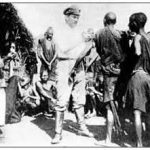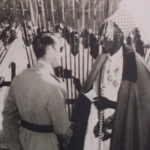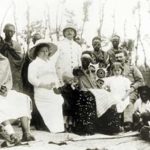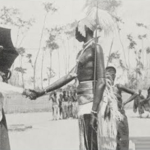Land Clientship
Control overland in pre-Rwabugiri Kinyaga was normally vested in lineages. Although land clientship was practiced in some forms these were of only minor significance in deterrnining access to land. NevertheIess, land clientship will be considered here because the early role of land patrons appears as a prototype of the role assumed by political authorities in subsequent periods. The growth of central administrative penetration in Kinyaga was reflected to a large degree in political control over land; as authorities appointed from above extended and consolidated their power, certain of the obligations which had earlier been associated with land clientship (to private land patrons) came to be imposed in a regular fashion on the general population (subject to “political” patrons).
The two principal types of land tenure in mid-nineteenth century Kinyaga were ubukonde (land which had been cleared and settled by the lineage occupying it or their ancestors) and igikingi (land held by a cattle-owning lineage, granted by the king or another political officia1). As used in Kinyaga, the termubukonde generally referred to land which had not been received from a political authority, and which had been occupied for many years by the same lineage. Immigrants to the region who received land from lineages holding ubukonde land would become land clients (abagereerwa) and they would be expected to contribute certain food products to the donor lineage as a form of rent. Land clients sometimes worked for one or two days per five-day week for their land patron, but it appears that this was only casually enforced, and was shared among the client lineage as a group.
Social relations between land patrons and their clients were characterized by strong affective ties; outsiders who received land on the ubukonde domain enjoyed the position of a “relative of inferior rank.Even thesubordinate status could disappear over time, as land clients often forged close ties to the donor lineage through neighborhood friendships, or marriage alliance. The descendants of those who married into the lineage would sometimes come to be recognized members of the donor kin group. A practice of imposing an excessive demand for
marriage payment encouraged such adoption of children into the donor lineage. The ubukonde patron would demand a cow as marriage payment for his daughter; the suitor would pay several hoes, promising to produce the cow later. As the young man could rarely come up with the promised cow, his children would remain legal members of their mother’s lineage, since the bridewealth had not been paid in full.
During the 1930s, it was reported that the obligations of land clients consisted of giving a portion of the harvest to land patrons, and gifts of beer from time to time. However, these obligations were carried out only erratically, and boundaries of agricultural land other than banana plantations were neither carefully demarcated nor rigidly enforced. While this situation may have resulted from changes during the colonial period, evidence about early land clientship in Kinyaga suggests that the casual nature of land clientship obligations represented a continuation of precolonial practices.
Another form of land clientship was associated with igikingi holdings, containing land suitable for pasturage of cattle. Such domains were held by cattle-owning lineages and by political officials (who generally had cattle}. In addition to pasturage, an igikingi (pl. ibikingi) normally included agricultural land cultivated by the proprietor lineage and any land clients attached to that lineage. The king granted rights over an igikingi to his army chiefs and other favorites; they in turn could grant portions to subordinates. The recipient of an igikingi exercised total jurisdiction within the boundaries of his “domain,” so that groups or individuals who came to settle within the igikingi became the “clients” of the proprietor, and, presumably, no administrative official was authorized to interfere with the proprietor’s jurisdiction over these clients. Ingobyi was a smaller portion of land held by a cattle-owner, normally sufficient only for the single lineage to which it was granted.
The proprietor of an igikingi could permit others, Tuutsi as well as Hutu, to live within the domain; they furnished, in return, certain obligatory prestations. Cattle-owning Tuutsi who lived within the igikingi and grazed their cattle on igikingi land were expected to aid in the construction and maintenance of the proprietor’s enclosure, and to perform other duties relating to care of the proprietor’s cattle. Hutu contributed agricultural labor or other services to their land “patron.” Need for protection was sometimes important in seeking igikingi land chentship. Such was the putative motivation for Hututo take up residence on one igikingi near the Rusizi River; by grouping themselves around the land “patron,” they obtained protection from raids by Shi coming from the western bank of the river.
The appearance of ibikingi marked an important development in Rwandan political organization. This institution was of relatively recent origin; it did not become common in the central regions of the kingdom until early in the nineteenth century (during the reign of Rwabugiri’s grandfather Yuhi Gahindiro) and was introduced to peripheral areas such as Kinyaga only much later. Although Kinyagans are familiar with the meaning of igikingi, traditions are vague about such grants for the nineteenth century; it is probable that igikingi and ingobyi land holdings were rare in the region until the time of Rwabugiri. Indeed, many Kinyagans assert that until late in the nineteenth century control over land depended on the right of occupation. Specified rights over pasture were allocated only to a few hills in Impara and Abiiru that were settled by cattle-owning lineages with links to central Rwanda. In pre-Rwabugiri Kinyaga, land clientship, whether on ubukonde or igikingi domains, was less important than other forms of land tenure. Lineages holding ubukonde land or igikingi land did not necessarily have c1ients. Moreover, although immigration to Kinyaga by people from central Rwanda dated from at least the eighteenth century, informants maintain that until the reign of Rwabugiri there was still unoccupied land available. Thus, immigrants coming to Kinyaga often could mark out their own domains, not being constrained to enter into land clientship. Land could also be obtained through purchase in some parts of the region. Early land clientship was practiced mainly by those having limited resources, needing protection, and lacking kin to assist them. Thus the control over land later ohtained by political authorities from central Rwanda and the exactions imposed on Kinyagans as the price for continued occupation of their land must be seen as innovations, representing a major departure from past practices
https://uk.amateka.net/land-clientship/https://uk.amateka.net/wp-content/uploads/2020/05/lands.pnghttps://uk.amateka.net/wp-content/uploads/2020/05/lands-150x150.pngChanges and ColonialismControl overland in pre-Rwabugiri Kinyaga was normally vested in lineages. Although land clientship was practiced in some forms these were of only minor significance in deterrnining access to land. NevertheIess, land clientship will be considered here because the early role of land patrons appears as a prototype of the...BarataBarata rpierre@ikaze.netAdministratorAMATEKA | HISTORY OF RWANDA




